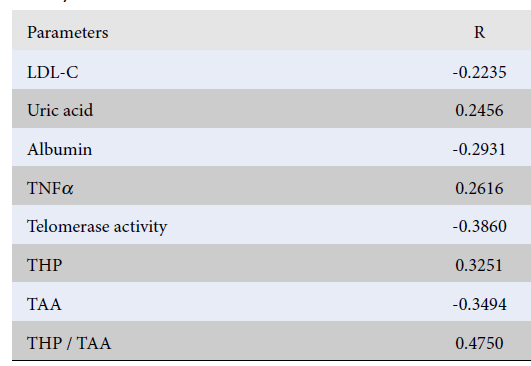Association of SIRT1 with metabolic parameters and aging rate
DOI:
https://doi.org/10.15419/bmrat.v10i3.796Keywords:
biological age, accelerated ageing, PhenoAge epigenetic clock, SIRT1, SIRT1 SNP gene polymorphismAbstract
Introduction: SIRT1 has attracted great interest due to its role as a regulator of longevity, and its therapeutic potential for the prevention and treatment of aging and age-related comorbidities. However, the mechanisms by which SIRT1 influences the course of aging remain unknown.
Methods: The study population included 88 apparently healthy subjects aged 31 ? 65 without established atherosclerotic cardiovascular disease or metabolic-associated diseases. Clinical, anthropometric, and biochemical parameters were determined in all patients. Molecular genetic studies included the determination of the C/G polymorphism of the SIRT1 gene (SIRT1, rs7069102), relative telomere length of blood leukocytes (RTL-b), and telomerase activity. Biological age was calculated using the DNAm PhenoAge epigenetic clock.
Results: The SIRT1 serum levels in carriers of different genotypes of the G/C polymorphism (rs7069102) and in patients of different age groups did not differ. SIRT1 plasma levels in the accelerated aging group were significantly higher in comparison with the healthy aging group: (4.16 ? 1.18) ng/ml vs (3.47 ? 0.76) ng/ml, respectively (p = 0.00066). Correlation analysis revealed a positive correlation of the SIRT1 serum level with uric acid (R = 0.25; p = 0.023), tissue necrosis factor (R = 0.26; p = 0.014), total hydroperoxides (R = 0.33; p = 0.003) and a negative correlation with low-density lipoprotein cholesterol (R = -0.22; p = 0.039), telomerase activity (R = -0.39; p = 0.001) and total antioxidant activity (R = -0.35; p = 0.001). Stepwise regression analysis revealed negative association of the SIRT1 serum level with biological age.
Conclusion: SIRT1 plasma levels in apparently healthy subjects were associated with age, body mass index (BMI), WC, factors of carbohydrate metabolism, and markers of the pro-antioxidant balance. A comparative analysis of SIRT1 plasma levels between accelerated and healthy aging groups showed a significant difference. However, our study did not confirm that SNPs (rs7069102) of the SIRT1 genotypes are associated with SIRT1 plasma level, aging rate, or any metabolic parameters.

Published
Issue
Section
License
Copyright The Author(s) 2017. This article is published with open access by BioMedPress. This article is distributed under the terms of the Creative Commons Attribution License (CC-BY 4.0) which permits any use, distribution, and reproduction in any medium, provided the original author(s) and the source are credited.
